The search for new oil and CO2 storage resources: residual oil zones in Australia
Aleksandra Kalinowski A * , Eric Tenthorey
A * , Eric Tenthorey  A , Mojtaba Seyyedi
A , Mojtaba Seyyedi  B and Michael Ben Clennell
B and Michael Ben Clennell  B
B
A Geoscience Australia, Symonston, ACT, Australia.
B CSIRO, Kensington, WA, Australia.
The APPEA Journal 62(1) 281-293 https://doi.org/10.1071/AJ21077
Submitted: 14 January 2022 Accepted: 24 February 2022 Published: 13 May 2022
© 2022 The Author(s) (or their employer(s)). Published by CSIRO Publishing on behalf of APPEA. This is an open access article distributed under the Creative Commons Attribution 4.0 International License (CC BY).
Abstract
Residual oil zones (ROZs) could present a new, potentially large and commercially viable oil resource for Australia and provide an avenue for geological storage of carbon dioxide (CO2) through CO2 enhanced oil recovery (CO2-EOR). These reservoirs, which can contain a moderate amount of residual oil and resemble water-flooded oil fields, can be associated with conventional fields (brownfields) or occur with no associated main pay zone (greenfields). Both types of ROZ are currently produced commercially through CO2-EOR in the Permian Basin, USA, and are of growing interest internationally, but our understanding of the occurrence and economic viability of oil production from ROZs in Australia is limited. We are employing geological and petrophysical methods to identify, map and quantify the potential oil resources of ROZs, initially in central Australian basins. Complementing this, we are conducting a series of CO2 core-flooding experiments combined with reservoir modelling to investigate the techno-economic feasibility of producing oil and storing CO2 in these formations. We aim to establish and test a workflow for characterising and evaluating ROZs in Australia. ROZs could prove to be good targets for CO2-EOR+, potentially even producing carbon-neutral or carbon-negative oil by using CO2 from anthropogenic sources, such as from blue hydrogen production.
Keywords: CO2-EOR, carbon capture utilisation and storage, CCUS, Cooper Basin, core‐flooding experiments, enhanced oil recovery, Exploring for the Future, petrophysics, residual oil zone, ROZ, subsurface characterisation.
Introduction
Australia is entering a new era of carbon abatement activity, with significant investment in low-emissions technologies underpinned by the Australian Government’s commitment to achieving net zero carbon dioxide (CO2) emissions by 2050 (COAG Energy Council 2019; DISER 2019a, 2019b, 2021a, 2021b). There is, however, a continued reliance on fossil fuels in Australia, particularly with respect to gas and oil. Domestic production of crude oil and refined products is in deficit, with Australia becoming increasingly more dependent on imported crude oil and refined products (Geoscience Australia 2021) (Fig. 1). Producing oil fields are depleting at a rate that surpasses the development of new resources/fields, and oil production is declining as a result (Geoscience Australia 2021). CO2 enhanced oil recovery (CO2-EOR) is one technology that can both produce more oil domestically and, at the same time, geologically store CO2.
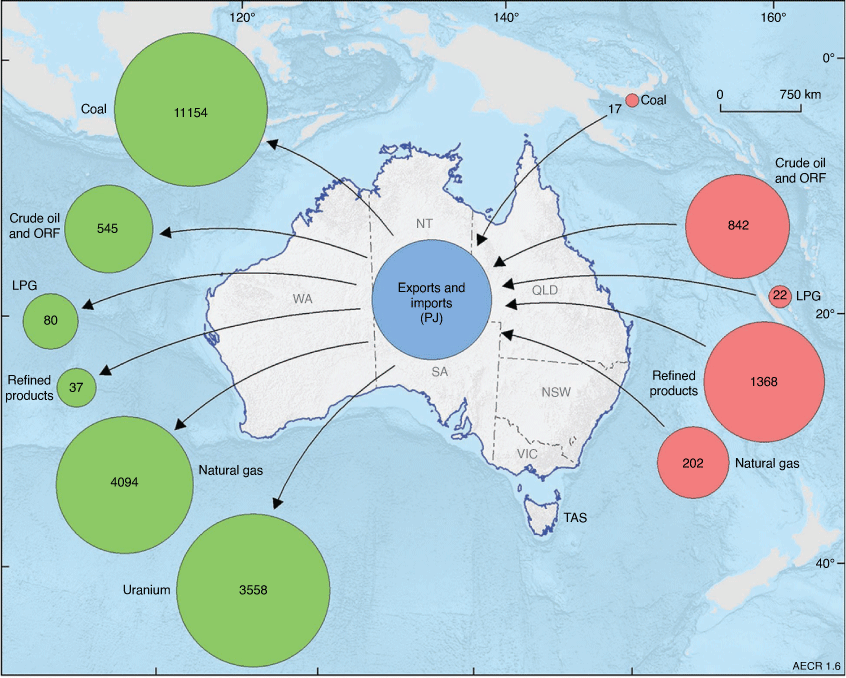
|
Despite being considered a business-as-usual activity for decades elsewhere in the world, CO2-EOR has not become well-established in Australia, although some examples exist. In the Cooper Basin, successful natural gas and ethane injection was carried out for EOR in the Tirrawarra Oil Field from 1984 to 1996, followed by further gas (with CO2) miscible EOR efforts at Tirrawarra and Fly Lake fields (Brown and Barley 1986; Frears 1998; Gravestock et al. 1998; Pedler 2009; Radke 2009; Santos 2016; Winterfield 2020). In 2020, further CO2 injection trials were conducted by Santos in depleted gas reservoirs as part of the Moomba Carbon Capture and Storage (CCS) project (Santos 2020). In the Surat Basin, Bridgeport Energy is currently testing the potential for CO2-EOR at the Moonie Oil Field (https://newhopegroup.com.au/bridgeport/; Barakat et al. 2019).
Since 2019, Geoscience Australia has been looking at the potential for CO2-EOR in Australia and at the barriers for its deployment. A screening study of Australia’s key hydrocarbon provinces showed that, in many cases, the geological, reservoir, and oil composition conditions in Australia are suitable for CO2-EOR in depleted oil fields (Tenthorey et al. 2021a). Factors hindering deployment were largely non-geological, such as a lack of readily available CO2, limited infrastructure and high costs. In addition to pursuing increased oil production, we are interested in technologies or approaches that result in a net reduction of CO2 emissions. Globally, around 10% of captured anthropogenic CO2 is used for EOR (Melzer 2012; Kuuskraa et al. 2013; IEA 2019). In this context, we have been exploring the concept of CO2-EOR+, where more CO2 is stored than is produced over the lifecycle of oil, from production to consumption (Tenthorey et al. 2021b).
Geoscience Australia, in collaboration with CSIRO, is now conducting a 4-year project to investigate the potential application of CO2-EOR to unlock new oil and CO2 geological storage resources in residual oil zones (ROZs) in Australia. This project is supported through the 4-year, A$225 million Exploring for the Future (EFTF) program (www.ga.gov.au/eftf). Production of oil from ROZ is currently only occurring in the USA, largely in the Permian Basin, where the estimated technically recoverable oil resource in the San Andres and Cannon Reed formations is some 12 Gbbl from a calculated oil in place (OIP) of nearly 31 Gbbl (Koperna and Kuuskraa 2006; Koperna et al. 2006; Trentham 2011; Trentham and Melzer 2016; Roueché and Karacan 2018). Efforts are being made elsewhere to identify and capitalise on this potentially significant oil and CO2 storage resource, for example at the Pierce Oil Field in the North Sea (Stewart et al. 2018) and on the Norwegian continental shelf (Bergmo et al. 2018).
During the first phase of this project, a scoping study was completed to better understand what parameters are most important for developing CO2-EOR projects, and resulted in the development of a workflow to: (1) identify and characterise ROZs in Australia; (2) predict ROZ reservoir behaviour; and (3) assess the viability of oil production and CO2 storage through CO2-EOR (Kalinowski et al. 2022; Tenthorey et al. 2022). In this paper, we summarise the workflow that will be applied and tested in selected Australian hydrocarbon provinces to investigate their prospectivity for economically viable ROZs. The first stage of the process combines petroleum systems and geological knowledge with petrophysical methods, based largely on log resistivity signatures, to identify and characterise ROZs in previously drilled areas. We will then conduct a series of core-flooding experiments to determine how miscible CO2 will be with a given oil and how efficiently the oil can be extracted using EOR techniques. The final step will use the experimental data to develop models that can predict EOR production and CO2 storage efficiency in ROZs under various conditions.
CO2-EOR and ROZs
CO2-EOR
CO2-EOR is a proven technology that can extend the life of oil fields and improve the yield of oil and condensate, and it usually follows primary and/or secondary production (e.g. water-flooding) from main pay zones. CO2 is injected into a reservoir, where it mixes with, dissolves into and mobilises some of the remaining oil in the rock, allowing it to flow and be collected at producer wells (Fig. 2). When the CO2–oil mixture is collected at the producer wells, the two phases are separated, and the produced CO2 (less the amount stored or ‘lost’ to the reservoir) is recycled for ongoing EOR activities.
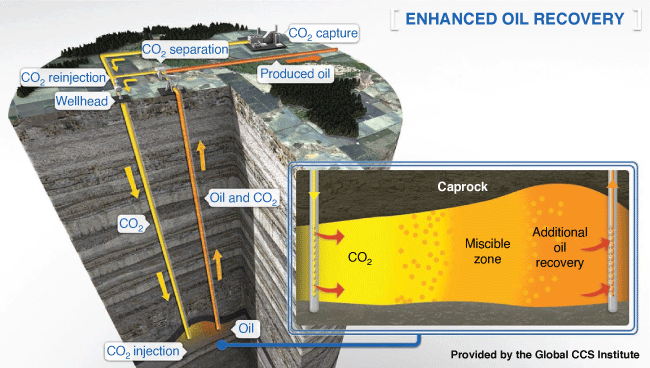
|
CO2-EOR has been used successfully for decades, beginning commercial oil production in the Permian Basin, USA, in 1972 (NETL 2010; McGlade et al. 2018). Establishment of CO2-EOR in the USA was aided by tax incentives, a high oil price at the time and the availability of large volumes of cheap CO2, largely derived from natural CO2 fields in moderate proximity to the oil fields, such as the CO2 fields at Sheep Mountain and McElmo Dome in Colorado. Some of the CO2 used for EOR in the USA is derived from anthropogenic sources, for example Exxon’s Shute Creek Gas Plant, which supplies CO2 for tertiary recovery in some Wyoming oil fields, or the Century plant in Texas (Hendricks 2009; Melzer 2012; Kuuskraa et al. 2013; IEA 2019).
Despite the success of this technology overseas, CO2-EOR has not gained much traction in Australia. Examples of its application include CO2 injection into the Fly Lake Field in the Cooper Basin and into the Moonie Oil Field in the Surat Basin (Pedler 2009; Winterfield 2020; https://newhopegroup.com.au/bridgeport/). Given that primary production recovery rates can vary considerably, from ~20–70% in Australia’s basins (Tenthorey et al. 2021a), this leaves a significant amount of OIP. The potential payoff of implementing CO2-EOR is large, as the technology has been shown to extend the productive life of oil fields, recovering up to 20% of the original OIP (US Chamber of Commerce 2013). Globally, EOR is responsible for about 2% of total oil supply (IEA 2018; McGlade et al. 2018).
ROZs
CO2-EOR usually targets oil left behind in the main pay zone. Over the past 10–15 years, however, the role of CO2-EOR has expanded to target zones beneath or adjacent to oil fields, where water has naturally invaded reservoirs that were originally saturated with oil. The result is a ROZ that contains some immobile oil saturation that could be produced through CO2-EOR. ROZs may form for different reasons, including (1) basin tilting, which causes a new oil–water contact to be established, leaving a residual oil wedge; or (2) due to a seal breach that has allowed natural leakage of oil from the structure, leading to water invasion from the underlying aquifer.
ROZs can be characterised as brownfield or greenfield (Fig. 3). Brownfield ROZs are those that are associated with a conventional oil accumulation and will generally form by the processes described above, whereas greenfield ROZs are not associated with any conventional accumulation and may represent oil displaced laterally by tilting or hydrodynamic drive. Brownfield examples are more common, with many fields having been produced in the USA, particularly from the San Andres Formation in the Permian Basin. Examples include the Seminole and Wasson fields, Chevron’s Vacuum Field, Fasken’s Hanford Field and XTO/ExxonMobil’s Salt Creek and Means fields (Koperna et al. 2006; Allison and Melzer 2017). The Seminole Field, having undergone primary, secondary (water-flood), tertiary (CO2-EOR) and now brownfield ROZ production, has played a key role in the commercialisation of ROZ and is projected to produce an additional 225 MMbbl of oil from the ROZ (Trentham et al. 2015).
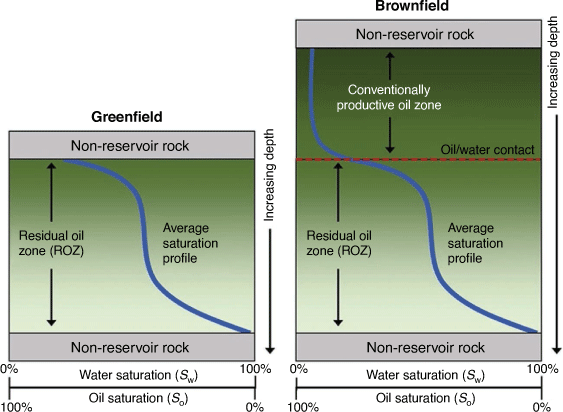
|
In the case of greenfield ROZs, a ROZ may represent oil migration pathways or perhaps oil that was spilled over from a filled structure. A notable example of a producing greenfield ROZ is Kinder Morgan’s Tall Cotton Field, which is located to the west of the Seminole Field in the Permian Basin. The Tall Cotton CO2-EOR project began in 2014 and by the end of 2018 was producing more than 3000 barrels of oil per day from a ~91 m-thick reservoir with an oil saturation of ~30% (Allison and Melzer 2017; Kinder Morgan 2018, 2020; Trentham and Melzer 2019). This points to the great potential of ROZ production for improving the productivity of current fields and, when greenfields are involved, for discovering new resources.
In addition to boosting hydrocarbon reserves, ROZ development also has the potential to store significant quantities of CO2 as part of the process (Hornafius and Hornafius 2015; IEA 2015). Tenthorey et al. (2021b) outlined the concept of CO2-EOR+, where EOR is performed to maximise CO2 storage, contrary to most projects today. Generally, CO2 utilisation per barrel of oil produced is greatest in the early stages of EOR projects and decreases with time, with average CO2-EOR projects using 0.3–0.5 tCO2 per barrel of oil produced (Azzolina et al. 2016; Tenthorey et al. 2021b). Some conventional EOR projects have been known to use significantly more CO2 per barrel produced, to the point that they can be considered carbon negative in terms of overall emissions (ARI 2010; Hornafius and Hornafius 2015; Sminchak et al. 2020; Tenthorey et al. 2021b). An example is CO2-EOR in the Salt Creek Field in Wyoming, where an excess of 0.9 tCO2 has been stored per barrel of oil produced (Hornafius and Hornafius 2015), placing the project well within the carbon-negative emissions category. We recognise, however, that such examples are rare, particularly since most EOR operations seek to minimise the use of CO2 due to cost.
Identifying, characterising and testing the viability CO2-EOR production from ROZ in Australia
Petrophysics and subsurface characterisation
Residual oil, by definition, does not flow to a well, and so it mostly will not be collected (except for some soluble compounds) in fluid samples taken during well tests or in repeat formation tests. Cores and cuttings taken from a ROZ will exhibit strong ‘oil shows’, while gas logs will show the presence of elevated hydrocarbons below the main pay zone. Cores that have been reasonably well preserved can be subjected to the Dean–Stark extraction process to determine the remaining oil saturation. So called sponge cores can also be used (Pathak et al. 2012), or even pressure cores, although these are expensive or rarely used. Core analysis is therefore a very time consuming and unrealistic way of identifying ROZ when looking at a whole basin, as is being done in this study. Petrophysical methods, which look at well log signatures from many wells, are therefore the preferred option.
Oil still present in the pore space of the reservoir can be detected by a number of downhole petrophysical methods, some of which can be used to quantify the saturation, while others can help to detect otherwise missed oil and help determine its habitat within the pore space. An example from a well in the Timor Sea, Ludmilla 1, is shown (Fig. 4). Fluid inclusion analysis (Dutkiewicz 1998) and hydrocarbon shows from the core (Woodside 1998) indicate a substantial ROZ beneath a thin column of producible oil in the Nancar sands, and this is backed up by direct petrophysical evidence of some remaining OIP (Fig. 4).
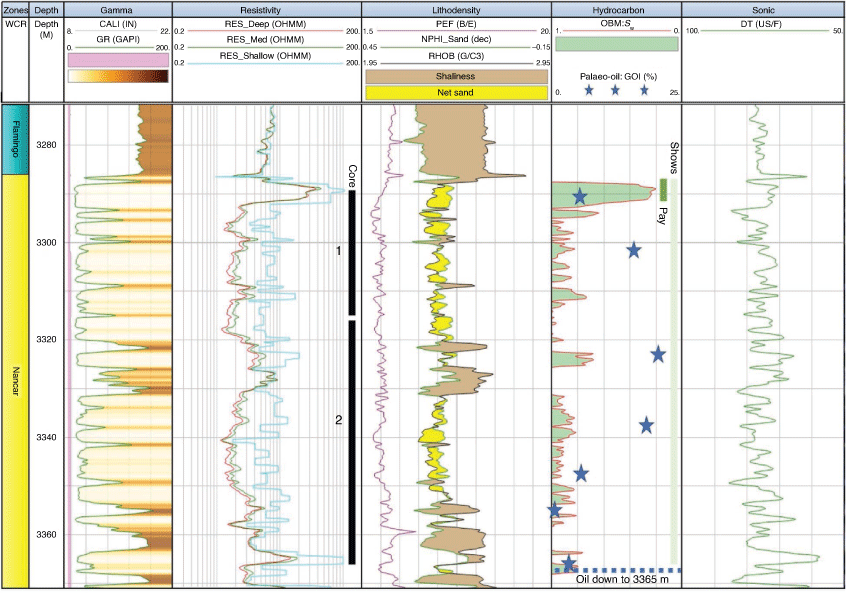
|
Resistivity-based methods are the mainstay of oil saturation determination (see Kennedy 2015), and this also applies to measuring OIP below the main pay zone. All resistivity methods are based on the fact that formation water conducts electricity, whereas both oil and the majority of rock grains are insulators. The contrast between water-bearing rock resistivity and oil-bearing rock resistivity is greatest when saturation of oil is high and saturation of water is low, making the conductive pathways sparse, poorly interconnected or highly convoluted so that the resistivity increases markedly (sometimes by orders of magnitude) above the baseline for the water-saturated reservoir rock. Variations from the conceptual model are as follows. If the formation water is fresh, then it does not conduct electricity well, perhaps giving a false impression of moderate hydrocarbon saturation. The presence of clays, which contain exchangeable cations, act as a conductive element of the bulk rock volume, invalidating the assumption of an insulating rock matrix substrate. If there is a substantial proportion of clays in the reservoir rock, then one needs to use a more advanced type of petrophysical analysis, but if the reservoir is ‘clean’ sandstone or limestone, and in the presence of moderately or strongly saline water, one can use a classical resistivity analysis for computing oil saturation that was developed by Gus Archie in the 1940s, and later by Pickett (1973).
The first step in standard Archie analysis is to examine the baseline conditions where the same rock formation as the oil reservoir is water-saturated. Typically, this is acquired from the water leg below the main pay zone and the transition zone within the same reservoir; but, if a ROZ is suspected, then one must attempt to find a water-saturated sandstone that has no evidence of oil shows from mud logs, gas logs or geological observations of cuttings and/or cores. Archie’s second equation goes on to relate the resistivity of the rock containing oil and/or gas to that of the same rock in the baseline condition, and in doing so, reveals zones that have significant oil remaining in the pores, which are the ROZs being sought. Importantly, since only the water phase (brine) conducts electricity and oil, gas and CO2 do not, we use only the water saturation Sw in the Archie equations, and the sum of saturations (water, plus oil, plus any gas or CO2) adds up to 1. CO2, gas and oil cannot be distinguished by electrical resistivity.
It should be emphasised that the methodology described above is a conceptual summary of how resistivity logs are used to identify ROZs. In practice, there are variables in the equations that factor in pore shape and porosity, which must be partly determined using experimental means. If oil-based mud (OBM) rather than water-based mud is used to drill the well, then the log density reading used to compute rock porosity in permeable reservoir zones requires correction. With OBM, the shallow resistivity reads higher than the deep resistivity owing to the invasion of the near-wellbore region, and if the depth of invasion is too great, then the deep reading, used to compute hydrocarbon saturation, may itself be affected. Furthermore, as mentioned above, a more sophisticated analysis is needed when the rock formation contains appreciable clays. In such a case, a key assumption of Archie’s Law is invalid, meaning the equation has to be modified using a shaly sand model (see Ellis and Singer 2007; Kennedy 2015). Usually, laboratory measurements on core samples are needed to extract required parameters, such as the cation exchange capacity (surface charge density) and clay percentage and type. These are often collected as part of a special core analysis (SCAL) program (McPhee et al. 2015).
A complementary method of identifying potential ROZs is via neutron porosity logs. These logs respond to the hydrogen index of the formation, which may only change slightly between the water zone and a ROZ; so if the clay content is variable, the signature can be hard to discern. On the other hand, in limestone formations with little clay but where there is formation water chemistry, and so Rw is variable, Archie analysis may be unreliable, and neutron porosity–density porosity separation is relied on quite heavily to detect and quantify ROZs. For example, in the Seminole Field of the Permian Basin, the strongest indicator of ROZ presence is the neutron porosity response (Roueché and Karacan 2018).
A further family of petrophysical logs that may be useful in the ROZ-EOR context are cased-hole neutron logs. Pulsed neutron logs are capable of ‘seeing’ through a cased hole into a formation that may have been missed and/or bypassed. While not very accurate for saturation quantification when the amount of oil is small, a positive response from a pulsed neutron tool set up to determine carbon–oxygen–hydrogen ratios could indicate a zone that is worth further investigation. The reader is referred to documented technology demonstrations of neutron activation tools (Kerr and Woodhouse 1992; Schnorr 1996) and case studies using through-casing logging (May et al. 2008).
Once the existence of a ROZ has been established, a series of formation tests using a downhole-conveyed testing tool can be used to help understand the distribution of saturations in situ and to assess the mobility of the oil, for example using tracers that partition between oil and water (Silva et al. 2017) in a push–pull test, known as a single-well chemical tracer test (Doorwar et al. 2020). However, this site characterisation/production aspect is a step beyond the focus of this paper, and therefore, it will not be discussed further. The next step in our workflow is to determine whether the ROZs that have been identified using well log analysis will mix miscibly with CO2 and be produced effectively. This will require a series of CO2 core-flooding experiments to be conducted.
Quantifying oil recovery and CO2 storage efficiencies
Core-flooding experiments
Once ROZs have been identified using the petrophysical workflow described above, a series of core-flooding experiments are required to gain some understanding into the producibility of the oil under certain baseline conditions. This is done via a series of well-designed fluid flow experiments using a core-flooding rig equipped with an X-ray computed tomography (CT) scanner. The X-ray CT scanner provides critical insights regarding the fluid distributions, saturation contents, and trapping inside the rocks as well as reservoir rock heterogeneities, which can then be fed to the reservoir simulator for flow behaviour under a wider variety of conditions (Fig. 5).
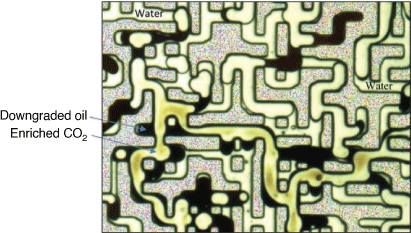
|
The fluid flow experiments are conducted at target ROZ reservoir conditions and wettability states. As such, in the case of having a mixed-wet or oil-wet ROZ, the rock samples need to go through an ageing process with crude oil (i.e. keeping the oil-saturated rock at high temperature for a few weeks). If the system is mostly water-wet, it is safe to use the rock ‘as is’ after the cleaning. In addition to the ageing process, a number of time-consuming steps to characterise brine permeability, heterogeneity, and initial water saturation are conducted via water-flooding experiments. Once these have been completed, CO2 tertiary flooding experiments can be performed.
Pure CO2, at the target ROZ’s reservoir conditions, is injected into the water-flooded reservoir rocks, and the oil recovery, fluids distributions, differential pressure and gas production are monitored. The injection continues until a plateau in oil recovery is reached and fluid distributions inside the reservoir rock remain unchanged. These experiments give us the following critical information:
Oil recovery trend vs pore volume of injection and time
Ultimate oil recovery factor
Injectivity vs pore volume of injection and time
CO2 storage potential vs pore volume of injection and time
Ultimate CO2 storage potential
CO2 utilisation factor vs pore volume of injection
Ultimate CO2 utilisation factor.
Compositional modelling
The experimental component only assesses the CO2–oil–rock behaviour under a few very specific conditions. It is therefore useful and even necessary to use these experimental results to calibrate compositional models that can then be applied to a wider variety of conditions and oil types. The data is fed into a reservoir simulator for history matching the experiments and effectively generating ‘digital’ rocks. These ‘digital’ rocks can then be used outside of the experimental conditions to simulate conditions relevant to specific reservoirs (e.g. matching oil compositions, initial conditions and so forth). They can be used to simulate different injection cycles, slug ratios/sizes and total injected volumes to assess the ROZ potential. The simulations allow us to further screen the reservoir candidates for CO2-EOR and storage. Ultimately, for the shortlisted candidates, compositional models at the reservoir scale can be built to evaluate the ROZ potential and all the associated metrics, such as production volumes and CO2 storage factors.
Discussion
Both mature hydrocarbon provinces and underexplored basins look promising for ROZs, for example the Cooper–Eromanga, Pedirka Amadeus Surat and Bonaparte basins (Newell 1999; Pepicelli 2018; Rendoulis 2018; Tenthorey et al. 2021a; Kalinowski et al. 2022). The initial application of our ROZ workflow will be on the Cooper–Eromanga basins, one of the few regions in Australia to have undergone EOR activities and one of the strategic areas of interest for the EFTF program.
Mature province example – Cooper–Eromanga basins
The Cooper–Eromanga basins form a mature, data-rich hydrocarbon province that produced 396 MMbbl of oil to end 2019 (Geoscience Australia 2021). Stratigraphy here consists of Late Carboniferous–Middle Triassic sediments of the Cooper Basin and Jurassic –Cretaceous sediments of the Eromanga Basin, with petroleum systems extending through both basins (Denaro et al. 2013) (Fig. 6).
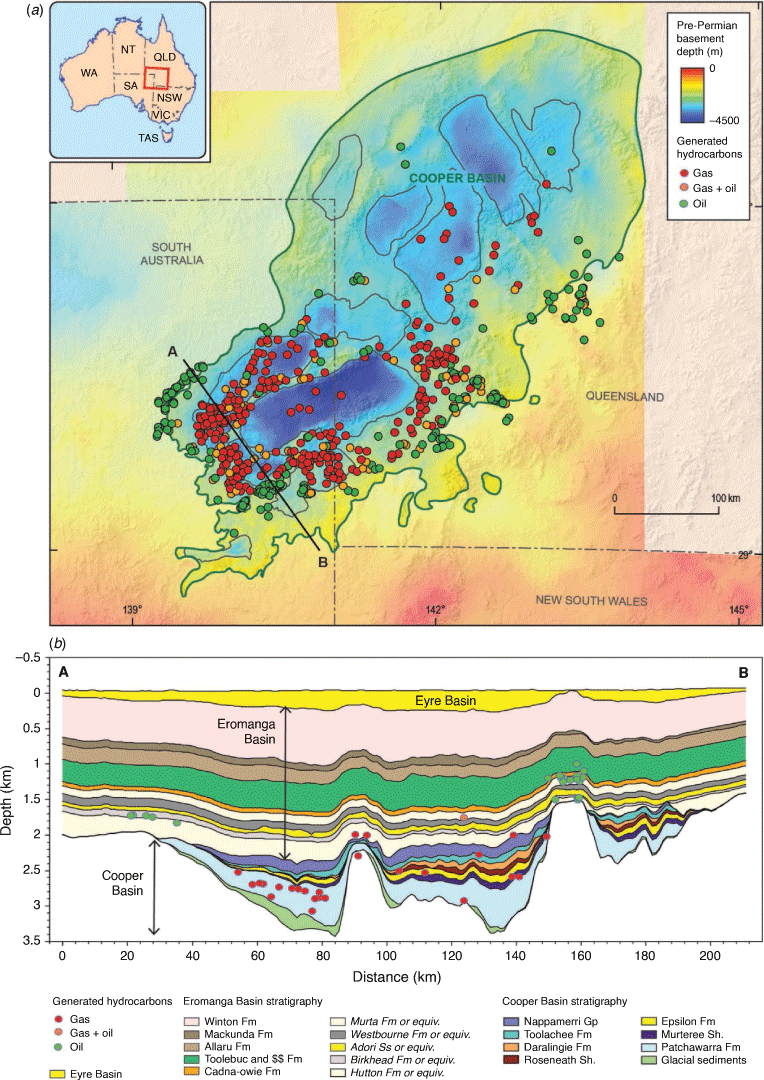
|
The main oil-bearing formations in the Cooper Basin are the Tirrawarra Sandstone, Patchawarra Formation and Toolachee Formation (Radke 2009; Carr et al. 2016), while in the overlying Eromanga Basin, the main oil units are the Poolowanna Formation, Hutton Sandstone, Birkhead Formation, Namur Sandstone and Murta Formation (Radke 2009; Randall 2013). Oil fields tend to consist of vertically stacked pools, and those in the Eromanga Basin reservoirs are located within close proximity to the extent of the Cooper Basin (Hall et al. 2019). This localisation reflects the occurrence of the Permian oil source rocks and migration pathways into Eromanga Basin reservoirs, where Cooper Basin seals were inadequate or breached (Alexander et al. 1998; Boreham and Summons 1999), although Jurassic-sourced oils occur in the basin as well. Such oil migration and paleo-oil columns could be useful indicators of ROZs.
Screening studies of the Cooper and Eromanga basins (e.g. Pepicelli 2018; Rendoulis 2018; Tenthorey et al. 2021a) found that these basins have suitable oil characteristics and geological conditions for CO2-EOR and are also close to a relatively pure source of CO2 generated by the Moomba gas processing facility. Tenthorey et al. (2021a) concluded that there could be significant remaining OIP for additional production via CO2-EOR. Santos recently reached a final investment decision for the Moomba CCS Project, which will store 1.7 MtCO2pa captured from the Moomba gas processing plant (Santos 2021). When established, this project could provide the required infrastructure and CO2 source for CO2-EOR operations in mature fields and potential ROZs. The success of the EOR programs at the Tirrawarra and Fly Lake fields (Patchawarra/Tirrawarra Sandstones) (Brown and Barley 1986; Frears 1998; Gravestock et al. 1998; Pedler 2009; Radke 2009; Santos 2016; Winterfield 2020) bodes well for further CO2-EOR operations in this region.
Underexplored region example – Pedirka Basin
The Pedirka Basin in central Australia is an immature, underexplored region that, to date, has not produced oil but may hold some potential in terms of ROZs (Fig. 7). It unconformably overlies the southeast Amadeus Basin and western Warburton Basin, which are also potential ROZ targets. Exploration in the Pedirka Basin started in the 1950s, but no oil was discovered until drilling in the Poolowanna Trough revealed uneconomic flows of oil from the Poolowanna-1 well in 1977 (Cotton et al. 2007). This result led to intensified interest in the 1980s, during which five more wells were drilled. Hydrocarbon shows have apparently been recorded from most wells, and in fact, Rawson Resources identified residual oil columns in the Colson-1, Poepells Corner-1 and Simpson-1 wells. Although these results are lacking a thorough assessment, they do suggest there is some potential for breached oil structures. While these wells may not be attractive targets for conventional oil accumulations, they may prove to be candidates for producible ROZs, possibly even of the greenfield variety.
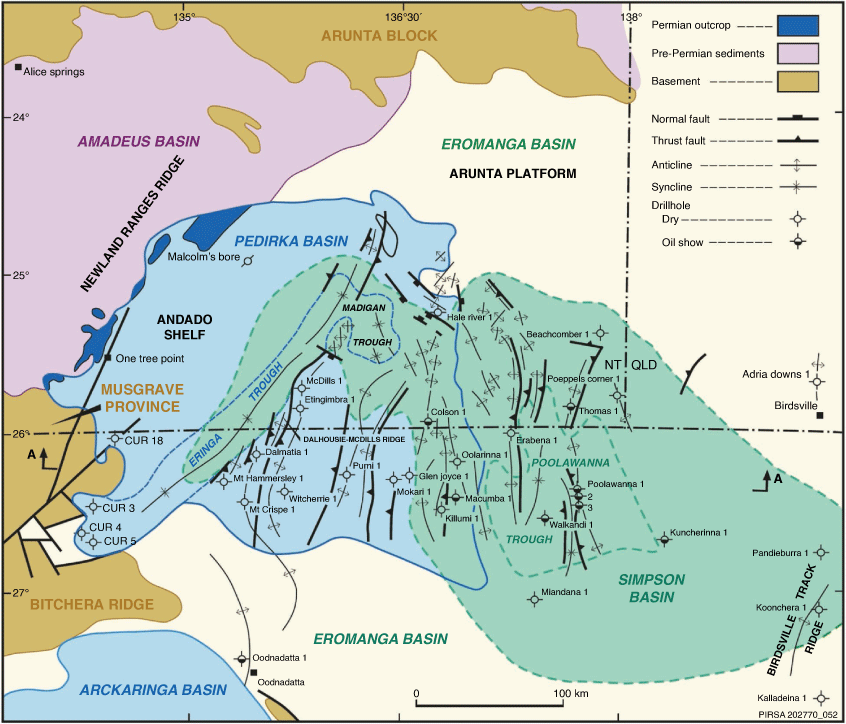
|
Development of CO2-EOR and ROZs in Australia
Several factors differentiate the successful USA ROZ examples from the development of ROZs in Australia. The long history of successful commercial CO2-EOR operations, ready availability of naturally occurring and anthropogenic CO2 and extensive CO2 infrastructure, particularly around the Permian Basin, have made ROZ development relatively straightforward in the USA. In addition, the Permian Basin fields are ‘giants’ located in unusually high-quality, oil-rich reservoirs, compared to the average Australian onshore oil fields, with larger associated ROZ volumes and thicker and more widespread oil-bearing formations than are likely to occur in Australia. This suggests that the technical and economic factors underpinning ROZ development in Australia are likely to be different and more financially challenging than the USA experience.
While CO2 has been available for EOR operations in the USA, it remains a limiting factor for the expansion of CO2-EOR in that region, as additional volumes are either not available or there is a constraint because of the high price of CO2. This has led to CO2 being piped from natural CO2 fields north of the Permian Basin, an endeavour that does not offset or eliminate emissions from the produced oil. In Australia, the CO2 sourcing issue may not prove to be such an impediment once CO2 capture becomes the norm or when CCS hubs and major CCS projects (such as the Moomba CCS Project in the Cooper Basin) become established. Many Australian gas fields hold very high concentrations of CO2, which is separated during the liquefied natural gas production process. This relatively pure stream of CO2 can be used for CO2-EOR or simply injected and stored, as is being done at the Chevron-led Gorgon Project on Barrow Island (https://australia.chevron.com/our-businesses/gorgon-project). Australia also seems to be on a path to becoming a global leader in hydrogen production, and if steam methane reformation is widely used to produce hydrogen, then another pure source of CO2 will be made available in various parts of the country.
Besides the major onshore hydrocarbon provinces in the Cooper and Bowen/Surat basins, many of Australia’s best oil basins lie in the offshore regions of the North West Shelf and Gippsland Basin. Examples of offshore CO2-EOR are rare – the most notable are Petrobras’ CO2-EOR activities in the Santos Basin Pre-Salt, Brazil, where 21.4 MtCO2 has been injected to June 2021 (Eide et al. 2019; https://co2re.co/StorageData). There are many technical and economic considerations that make offshore EOR more challenging than onshore projects. Challenges for offshore EOR compared to onshore EOR include the additional costs and logistics associated with fitting out offshore platforms for CO2-EOR, as well as the limited ‘surface’ footprint; frequent lack of a proximal CO₂ supply; insufficient knowledge of the reservoir; low well density and directional-type wells; limited/costly infrastructure and transportation; and greater primary production offshore potentially leaving a smaller residual resource (Eide et al. 2019). As the ultra-deep water Santos Basin example shows, these barriers can be overcome if the reward is substantial enough, and offshore floating vessels can be used effectively to make offshore EOR operations a success.
Another advantage held in the USA is the wealth of technical experience with CO2-EOR and the availability of a knowledgeable workforce, something that is currently lacking in Australia. Collaboration with international experts and the ability of international petroleum companies to draw on worldwide expertise should allow Australia to leapfrog at least some of the ‘growing pains’ associated with initiating this new industry. A similar shortcoming lies in the infrastructure readiness in Australia relative to the USA. More than 6500 km of dedicated CO2-transport pipelines in North America deliver CO2 to EOR fields across the continent. Despite having some good existing sources of anthropogenic/natural gas-related CO2 (and excellent future CO2-supply potential), Australia lacks the required infrastructure to transport CO2 from its source to the EOR site, especially considering the significant distances between most CO2 sources and oil fields. Road or rail transport of CO2 from sources to nearby EOR projects may work in the short term for areas that have co-located CO2 sources and oil fields, and tapping into established or developing CO2 storage projects or hubs is likely to be the most efficient path. For example, the Moomba CCS project in the Cooper Basin could offer an opportunity for that CO2 to be used for EOR operations in nearby oil fields or clusters, possibly with CO2 storage, for example using a ‘stacked reservoir’ approach where CO2-EOR produces oil from some reservoirs while overlying or underlying reservoirs are used purely for CO2 storage. Once CO2-transport infrastructure is established, and if the remaining OIP and ROZ resources are found to be significant, CO2-EOR may become more attractive across Australia.
There are a number of pieces of legislation and regulations in place, covering both onshore and offshore operations, that support CO2-EOR activities in Australia, for example the Offshore Petroleum and Greenhouse Gas Storage Act (2009) and equivalent state legislation governing onshore regions. CO2-EOR is currently included under usual petroleum production practice and not under carbon abatement measures, so there is no additional financial or carbon credit benefit from CO2-EOR in addition to the value of the produced oil. Currently, the prospective profitability of such endeavours appears to be insufficient as an incentive. The discovery of viable additional oil resources in ROZs, as well as the ability of CO2-EOR to mobilise hard-to-produce oil (e.g. in low-quality reservoirs) could, however, tip the balance. In addition, the successful demonstration of CO2-EOR+ could eventually lead to the inclusion of CO2-EOR as a true carbon abatement measure.
Summary
Evidence from the USA shows that significant oil resources can be produced from ROZs through CO2-EOR, and there is increasing global interest in this new resource. The Australian situation is more challenging, partly due to the lack of an established CO2-EOR industry and CO2 infrastructure. There are, however, signs that there may be opportunities for ROZ development in both mature hydrocarbon provinces, such as the Cooper/Eromanga and Surat basins, as well as in underexplored/undeveloped basins, such as the Pedirka and Amadeus basins. CO2-EOR in ROZs and in conventional depleted fields should therefore be considered in Australia as a technology that could help to accelerate the CCS industry and reduce the overall emissions footprint of hydrocarbon production.
Under a project supported by the EFTF program, Geoscience Australia and CSIRO are collaborating to define an innovative workflow to identify, characterise, quantify, predict and establish the feasibility of producing ROZs across Australia using test cases in central Australian basins. The approach includes combining petroleum systems knowledge with advanced petrophysical analysis, obtaining experimental core and oil data, and constructing ROZ reservoir models to further test and predict the resource and producibility of prospective regions.
With increasing technological development, often decreasing costs, and predicted future widespread deployment of CCS leading to readily availability of CO2 and related infrastructure, these resources that were once disregarded may become genuinely valuable prospects.
Data availability
There are no datasets associated with this publication.
Conflicts of interest
All authors confirm there are no conflicts of interest.
Declaration of funding
No funding from external organisations was received for this research.
Acknowledgements
The authors would like to thank Diane Jorgensen and Andrew Feitz (Geoscience Australia) and reviewers for the APPEA Technical Program Committee, for their insightful and constructive feedback, and acknowledge the contributions of the project teams at Geoscience Australia and CSIRO. This paper is published with the permission of the CEO, Geoscience Australia.
References
Alexander EM, Gravestock DI, Cubitt C, Chaney A (1998) Lithostratigraphy and environments of deposition. In ‘Petroleum Geology of South Australia, Volume 4: Cooper Basin’. (Eds DI Gravestock, J Hibburt, JF Drexel) pp. 69–116. (Primary Industries and Resources SA). Available at https://www.petroleum.sa.gov.au/data-centre/publications-and-presentations/petroleum-geology-of-south-australia/slider/volume_4_-_cooper_basinAllison J, Melzer S (2017) Tall Cotton CO2 EOR ROZ Greenfield Flood. Presentation. Available at https://www.co2conference.net/wp-content/uploads/2017/12/10-Allison-Melzer-Tall-Cotton-Greenfield-ROZ-CO2-EOR-Project-Update-12-6-17.pdf
ARI (2010) Optimization of CO2 storage in CO2 enhanced oil recovery projects. Prepared for Department of Energy & Climate Change (DECC) Office of Carbon Capture & Storage. November 30, 2010. Available at https://assets.publishing.service.gov.uk/government/uploads/system/uploads/attachment_data/file/47992/1006-optimization-of-co2-storage-in-co2-enhanced-oil-re.pdf
Azzolina, NA, Peck, WD, Hamling, JA, Gorecki, CD, Ayash, SC, Doll, TE, Nakles, DV, and Melzer, LS (2016). How green is my oil? A detailed look at greenhouse gas accounting for CO2-enhanced oil recovery (CO2-EOR) sites. International Journal of Greenhouse Gas Control 51, 369–379.
| How green is my oil? A detailed look at greenhouse gas accounting for CO2-enhanced oil recovery (CO2-EOR) sites.Crossref | GoogleScholarGoogle Scholar |
Barakat, S, Cook, B, D’Amore, K, Diaz, A, and Bracho, A (2019). An Australian first initiative to re-develop the first commercial onshore oilfield into a CO2 miscible-EOR project. The APPEA Journal 59, 179–195.
| An Australian first initiative to re-develop the first commercial onshore oilfield into a CO2 miscible-EOR project.Crossref | GoogleScholarGoogle Scholar |
Bergmo, PES, Grimstad, A-A, and Kurtev, K (2018). Mapping of paleo residual oil zones on the NCS and the potential for production by CO2-EOR. International Journal of Greenhouse Gas Control 75, 254–261.
| Mapping of paleo residual oil zones on the NCS and the potential for production by CO2-EOR.Crossref | GoogleScholarGoogle Scholar |
Boreham, CJ, and Summons, RE (1999). New insights into the active petroleum systems in the Cooper and Eromanga Basins, Australia. The APPEA Journal 39, 263–296.
| New insights into the active petroleum systems in the Cooper and Eromanga Basins, Australia.Crossref | GoogleScholarGoogle Scholar |
Brown, DJ, and Barley, MR (1986). Tirrawarra and Moorari enhanced oil recovery projects – ‘getting more oil out from down under’. The APPEA Journal 26, 389–396.
| Tirrawarra and Moorari enhanced oil recovery projects – ‘getting more oil out from down under’.Crossref | GoogleScholarGoogle Scholar |
Carr LK, Korsch RJ, Palu TJ, Reese B (2016) Onshore Basin Inventory: The McArthur, South Nicholson, Georgina, Wiso, Amadeus, Warburton, Cooper and Galilee Basins, central Australia. Record 2016/04. Geoscience Australia, Canberra.
| Crossref |
COAG Energy Council (2019) Australia’s National Hydrogen Strategy. Available at https://www.industry.gov.au/sites/default/files/2019-11/australias-national-hydrogen-strategy.pdf
Cotton TB, Scardigno MF, Hibburt JE (Eds) (2007) ‘The petroleum geology of South Australia. Vol. 2: Eromanga Basin. 2nd edn.’ (Department of Primary Industries and Resources, Petroleum Geology of South Australia Series: South Australia). Available at https://www.petroleum.sa.gov.au/data-centre/publications-and-presentations/petroleum-geology-of-south-australia
Denaro TJ, Randall RE, Smith RJ (2013) Chapter 10: Mineral and energy resources. In ‘Geology of Queensland’. (Ed. PA Jell) 970 pp. (Geological Survey of Queensland: Brisbane). Available at https://catalogue.nla.gov.au/Record/6155207
DISER (2019a) Australia’s Technology Investment Roadmap: discussion paper. Department of Industry, Science, Energy and Resources. Available at https://consult.industry.gov.au/climate-change/technology-investment-roadmap
DISER (2019b) National Resources Statement. Department of Industry, Science, Energy and Resources. Available at https://www.industry.gov.au/data-and-publications/australias-national-resources-statement/australias-national-resources-statement
DISER (2021a) Technology Investment Roadmap: Low Emissions Technology Statement 2021. Department of Industry, Science, Energy and Resources. Available at https://www.industry.gov.au/data-and-publications/technology-investment-roadmap-low-emissions-technology-statement-2021
DISER (2021b) Australia’s Long-Term Emissions Reduction Plan. Department of Industry, Science, Energy and Resources. Available at https://www.industry.gov.au/data-and-publications/australias-long-term-emissions-reduction-plan
Doorwar S, Tagavifar M, Dwarakanath V (2020) A 1D Analytical Solution to Determine Residual Oil Saturations from Single-well Chemical Tracer Test. Paper presented at the SPE Improved Oil Recovery Conference, SPE, Virtual, August 2020.
| Crossref |
Dutkiewicz A (1998) Hydrocarbon charge history of reservoir sandstones from Ludmilla-1, AC/P16, Timor Sea. Australian Petroleum Cooperative Research Centre Confidential Report No. 358. Available appended to Woodside: Ludmilla-1 Interpretative Well Completion Report pages 244–264.
Eide, LI, Batum, M, Dixon, T, Elamin, Z, Graue, A, Hagen, S, Hovorka, S, Nazarian, B, Nøkleby, PH, Olsen, GI, Ringrose, P, and Vieira, RAM (2019). Enabling Large-Scale Carbon Capture, Utilisation, and Storage (CCUS) Using Offshore Carbon Dioxide (CO2) Infrastructure Developments – A Review. Energies 12, 1945.
| Enabling Large-Scale Carbon Capture, Utilisation, and Storage (CCUS) Using Offshore Carbon Dioxide (CO2) Infrastructure Developments – A Review.Crossref | GoogleScholarGoogle Scholar |
Ellis DW, Singer JM (2007) ‘Well Logging for Earth Scientists. 2nd edn.’ (Springer: Dordrecht). Available at https://link.springer.com/content/pdf/10.1007% 2F978-1-4020-4602-5.pdf
Frears RA (1998) Chapter 11: Recovery technology. In ‘Petroleum Geology of South Australia, Volume 4: Cooper Basin’. (Eds DI Gravestock, J Hibburt, JF Drexel). pp. 181–188. (Primary Industries and Resources SA). Available at https://www.petroleum.sa.gov.au/data-centre/publications-and-presentations/petroleum-geology-of-south-australia/slider/volume_4_-_cooper_basin
Geoscience Australia (2021) Australia’s Energy Commodity Resources (AECR). Available at https://www.ga.gov.au/digital-publication/aecr2021
Gravestock DI, Jensen-Schmidt B, Sansome A (1998) Chapter 12: Field summaries. In ‘Petroleum Geology of South Australia, Volume 4: Cooper Basin’. (Eds DI Gravestock, J Hibburt, JF Drexel) (Primary Industries and Resources SA). pp. 189–196. Available at https://www.petroleum.sa.gov.au/data-centre/publications-and-presentations/petroleum-geology-of-south-australia/slider/volume_4_-_cooper_basin
Hall, LS, Palu, TJ, Murray, AP, Boreham, CJ, Edwards, DS, Hill, AJ, and Troup, A (2019). Hydrocarbon prospectivity of the Cooper Basin, Australia. AAPG Bulletin 103, 31–63.
| Hydrocarbon prospectivity of the Cooper Basin, Australia.Crossref | GoogleScholarGoogle Scholar |
Hendricks K (2009) Experiences in the Salt Creek Field CO2 flood. In '5th Annual Wellbore Integrity Network, May 13–14, 2009, Calgary, Alberta'.
Hornafius, KY, and Hornafius, JS (2015). Carbon negative oil: a pathway for CO2 emission reduction goals. International Journal of Greenhouse Gas Control 37, 492–503.
| Carbon negative oil: a pathway for CO2 emission reduction goals.Crossref | GoogleScholarGoogle Scholar |
IEA (2015) Storing CO2 through Enhanced Oil Recovery: Combining EOR with CO2 storage (EOR+) for profit. p. 48. Available at https://webstore.iea.org/insights-series-2015-storing-co2-through-enhanced-oil-recovery
IEA (2018) World Energy Outlook, 2018. Available at https://www.iea.org/reports/world-energy-outlook-2018
IEA (2019) ‘Can CO2-EOR really provide carbon-negative oil?’ (IEA: Paris). Available at https://www.iea.org/commentaries/can-co2-eor-really-provide-carbon-negative-oil
Kalinowski A, Tenthorey E, Taggart I, McKenna J (2022) ‘Residual oil zones: review of current practice and experience.’ Geoscience Australia Record, Geoscience Australia, Canberra (in press).
Kennedy M (2015) ‘Practical Petrophysics.’ (Elsevier: The Netherlands)
Kerr SA, Woodhouse R (1992) The evaluation of oil saturation through casing using carbon/oxygen logs. The Log Analyst 33(01). Paper no. SPWLA-1992-v33n1a1. Available at https://onepetro.org/petrophysics/article-abstract/170801/The-Evaluation-Of-Oil-Saturation-Through-Casing?redirectedFrom=fulltext
Kinder Morgan (2018) Tall Cotton (San Andres) Field. Presentation at Midland CO2 Conference, 5 December 2018, Midland, Texas. Available at https://co2conference.net/presentation/tall-cotton-san-andres-field/
Kinder Morgan (2020) CO2 Overview. Available at https://www.kindermorgan.com/Operations/CO2/Index [Accessed November 2020]
Koperna GJ, Kuuskraa VA (2006) Technical Oil Recovery Potential from Residual Oil Zones: Permian Basin, Big Horn Basin and Williston. Prepared for U.S. Department of Energy, Office of Fossil Energy – Office of Oil and Natural Gas, February, 2006.
Koperna GJ, Melzer LS, Kuuskraa VA (2006) Recovery of oil resources from the residual and transitional oil zones of the Permian Basin. In ‘Society of Petroleum Engineers, SPE Annual Technical Conference and Exhibition, San Antonio, USA, 24–27 September 2006’. SPE-102972.
Kuuskraa, VA, Godec, ML, and Dipietro, P (2013). CO₂ utilization from “Next Generation” CO₂ Enhanced Oil Recovery technology. Energy Procedia 37, 6854–6866.
| CO₂ utilization from “Next Generation” CO₂ Enhanced Oil Recovery technology.Crossref | GoogleScholarGoogle Scholar |
May DH, Grant J, Pinto KT (2008) The use of pulsed neutron measurements for determination of bypassed pay: a multiwell study. Paper presented at the SPE Western Regional and Pacific Section AAPG Joint Meeting, Bakersfield, California, USA, March 2008. Paper No. SPE-114027-MS.
| Crossref |
McGlade C, Sondak G, Han M (2018) Whatever happened to enhanced oil recovery? (28 November 2018 – Commentary and 2018 EOR projects database). Available at https://www.iea.org/commentaries/whatever-happened-to-enhanced-oil-recovery
McPhee C, Reed J, Zubizarreta I (2015) ‘Core Analysis: A Best Practice Guide.’ (Elsevier: Amsterdam)
Melzer LS (2012) ‘Carbon dioxide enhanced oil recovery (CO2-EOR): factors involved in adding carbon capture, utilization and storage (CCUS) to enhanced oil recovery.’ (Centre for Climate and Energy Solutions)
NETL (2010) Carbon Dioxide Enhanced Oil Recovery. Available at https://www.netl.doe.gov/sites/default/files/netl-file/CO2_EOR_Primer.pdf
Newell, NA (1999). Water washing in the Northern Bonaparte Basin. The APPEA Journal 39, 227–247.
| Water washing in the Northern Bonaparte Basin.Crossref | GoogleScholarGoogle Scholar |
Pathak P, Fitz DE, Babcock KP, Wachtman RJ (2012) Residual oil saturation determination for EOR projects in Means Field, a mature West Texas carbonate field. SPE Res Eval & Eng 15(05), 541–553. Paper No. SPE-145229.
| Crossref |
Pedler I (2009) Enhanced oil recovery studies in the Tirrawarra Oil Field, Cooper Basin, South Australia. Presentation (Santos). Available at https://slideplayer.com/slide/7057514/
Pepicelli D (2018) Enhanced oil recovery: status and potential in Australia. Presentation at IEA EOR TCP, Copenhagen, Denmark, 6 September 2019. Government of South Australia. Available at https://www.petroleum.sa.gov.au/__data/assets/pdf_file/0011/274385/Pepicelli_-_IEA,_6Sep2018.pdf
Pickett, GR (1973). Pattern recognition as a means of formation evaluation. The Log Analyst 14, 3–11.
Radke B (2009) Hydrocarbon and geothermal prospectivity of sedimentary basins in central Australia: Warburton, Cooper, Pedirka, Galilee, Simpson and Eromanga Basins. Geoscience Australia Record 2009/25, 161p (eCat: 69150).
Randall RE (2013) Petroleum. In ‘Geology of Queensland’. (Ed. PA Jell) pp. 739–749. (Geological Survey of Queensland: Brisbane)
Rendoulis N (2018) ‘Potential for carbon dioxide EOR in the Cooper and Eromanga Basins.’ p. 66. (Department for Energy and Mining: South Australia). Available at https://www.petroleum.sa.gov.au/__data/assets/pdf_file/0004/274387/CO2_EOR_in_South_Australia_-_Final_Report.pdf
Roueché JN, Karacan CÖ (2018) Zone Identification and Oil Saturation Prediction in a Waterflooded Field: Residual Oil Zone, East Seminole Field, Texas, USA, Permian Basin, in Day 4 Tue, April 17, 2018. Presented at the SPE Improved Oil Recovery Conference, SPE, Tulsa, Oklahoma, USA, p. D041S022R002.
Sanguinito, S, Singh, H, Myshakin, EM, Goodman, AL, Dilmore, RM, Grant, TC, Morgan, D, Bromhal, G, Warwick, PD, Brennan, ST, Freeman, PA, Özgen Karacan, C, Gorecki, C, Peck, W, Burton-Kelly, M, Dotzenrod, N, Frailey, S, and Pawar, R (2020). Methodology for estimating the prospective CO2 storage resource of residual oil zones at the national and regional scale. International Journal of Greenhouse Gas Control 96, 103006.
| Methodology for estimating the prospective CO2 storage resource of residual oil zones at the national and regional scale.Crossref | GoogleScholarGoogle Scholar |
Santos (2016) South Australia Cooper Basin Environmental Impact Report: production and processing operations. Available at https://www.petroleum.sa.gov.au/__data/assets/pdf_file/0007/271267/20161216_-_Santos_Production_and_Processing_EIR_2016_Final_for_consultat....pdf
Santos (2020) Moomba carbon capture and storage injection trial successful (media release, 22 October 2020). Available at https://www.santos.com/news/moomba-carbon-capture-and-storage-injection-trial-successful/
Santos (2021) Santos announces FID on Moomba Carbon Capture and Storage Project (media release, 1 November 2021). Available at https://www.santos.com/news/santos-announces-fid-on-moomba-carbon-capture-and-storage-project/
Schnorr DR (1996) Determining oil, water and gas saturations simultaneously through casing by combining c/o & sigma measurements SPE-35682-MS.
| Crossref |
Seyyedi, M, and Sohrabi, M (2020). Oil Reservoir on a chip: Pore-scale study of multiphase flow during near-miscible CO2 EOR and storage. Transport in Porous Media 134, 331–349.
| Oil Reservoir on a chip: Pore-scale study of multiphase flow during near-miscible CO2 EOR and storage.Crossref | GoogleScholarGoogle Scholar |
Silva M, Stray H, Bjørnstad T (2017) Studies on new chemical tracers for determination of residual oil saturation in the inter-well region. Paper presented at the SPE Oklahoma City Oil and Gas Symposium, Oklahoma City, Oklahoma, USA, March 2017. Paper no. SPE-185085-MS.
| Crossref |
Sminchak, JR, Mawalkar, S, and Gupta, N (2020). Large CO2 storage volumes result in net negative emissions for greenhouse gas life cycle analysis based on record from 22 years of CO2-enhanced oil recovery 40 operations. Energy Fuels 34, 3566–3577.
| Large CO2 storage volumes result in net negative emissions for greenhouse gas life cycle analysis based on record from 22 years of CO2-enhanced oil recovery 40 operations.Crossref | GoogleScholarGoogle Scholar |
Stewart, RJ, Johnson, G, Heinemann, N, Wilkinson, M, and Haszeldine, RS (2018). Low carbon oil production: Enhanced oil recovery with CO2 from North Sea residual oil zones. International Journal of Greenhouse Gas Control 75, 235–242.
| Low carbon oil production: Enhanced oil recovery with CO2 from North Sea residual oil zones.Crossref | GoogleScholarGoogle Scholar |
Tenthorey E, Kalinowski A, Wintle E, Bagheri M, Easton L, Mathews E, McKenna J, Taggart I (2021a) Screening Australia’s basins for CO-Enhanced Oil Recovery. CO2CRC Limited, Melbourne, Australia.
Tenthorey, E, Taggart, I, Kalinowski, A, and McKenna, J (2021b). CO2-EOR+ in Australia: achieving low-emissions oil and unlocking residual oil resources. The APPEA Journal 61, 118–131.
| CO2-EOR+ in Australia: achieving low-emissions oil and unlocking residual oil resources.Crossref | GoogleScholarGoogle Scholar |
Tenthorey E, Kalinowski A, Seyyedi M, Jackson S, Clennell B (2022) ‘CO2 EOR -Storage Methodology in Residual Oil Zones.’ Record 2022/03 Geoscience Australia, Canberra.
| Crossref |
Trentham R (2011) Residual Oil Zones: The long term future of enhanced oil recovery in the Permian Basin and elsewhere. Adapted from oral presentation at AAPG Southwest Section meeting, Ruidoso, New Mexico, USA, June 5–7.
Trentham R, Melzer LS (2016) A “cookbook” approach to exploring for, and evaluating, residual oil zones in the San Andres Formation of the Permian Basin. Adapted from oral presentation given at 2019 AAPG Southwest Section Convention, Southwest Strategies – Stay the Course, Abilene, Tx, April 9–12, 2016. Search and Discovery Article #51259. Available at http://www.searchanddiscovery.com/documents/2016/51259trentham/ndx_trentham.pdf
Trentham R, Melzer LS (2019) A “cookbook” approach to evaluating residual oil zones completed as horizontal depressurizing (DUROZ) wells in the San Andres Formation. Adapted from oral presentation given at 2019 AAPG Southwest Section Annual Convention, Dallas, TX, April 6–9 2019. Search and Discovery Article #51570. Available at http://www.searchanddiscovery.com/documents/2019/51570trentham/ndx_trentham.pdf
Trentham R, Melzer S, Vance D, Kuuskraa V, Petrusak R (2015) Identifying and developing technology for enabling small producers to pursue the residual oil zone (ROZ) fairways in the Permian Basin San Andres - Final Report. (US Department of Energy)
US Chamber of Commerce (2013) CO2 Enhanced Oil Recovery: The US chamber of commerce, 2013. Available at https://www.globalenergyinstitute.org/sites/default/files/020174_EI21_EnhancedOilRecovery_final.pdf
Winterfield C (2020) Santos Energy Solutions – Moomba CCS Project. Presentation at 2020 South Australian Roundtable for Oil and Gas, 30 November 2020. Available at https://www.petroleum.sa.gov.au/media/shared/pdf/petroleum/roundtable/roundtable_meetings/roundtable-meeting-2020/Winterfield-Christian-Moomba-CCS-Project-2020-Roundtable-for-Oil-and-Gas-Final.pdf
Woodside (1998) Ludmilla-1 Well Completion Report.

Aleksandra Kalinowski is a Senior Geoscientist at Geoscience Australia and holds an undergraduate degree in Geology from the Australian National University (ANU) and a PhD from the University of New South Wales. She has worked extensively on Carbon Capture, Utilisation and Storage, including undertaking geological assessments for carbon dioxide (CO2) storage and working on technical and policy aspects of Carbon Capture and Storage (CCS) at the Massachusetts Institute of Technology’s Laboratory for Energy and the Environment and Harvard University’s Kennedy School of Government. Aleks continues to focus on low-emissions energy resources, most recently focusing on geological storage combined with utilisation of CO2 enhanced oil recovery (CO2-EOR), as well as hydrogen and geothermal energy. |

Eric Tenthorey is a Senior Researcher at Geoscience Australia, with expertise in geomechanics, carbon capture and other low carbon geoscience disciplines. He holds a PhD from Columbia University and has subsequently worked as a researcher at ANU. In 2007, he was engaged by Geoscience Australia to work as a geomechanics expert with the CO2CRC: a cooperative research centre focused on developing and proving up CCS technology. More recently, his work has centred on other low carbon geoscience sectors, such as the hydrogen energy future, geothermal energy, and CO2-EOR. |

Mojtaba Seyyedi is a Research Scientist at CSIRO Energy. He is a Reservoir Engineer specialising in CO2 utilisation/EOR and storage with over 10 years of international experience consulting for the world’s leading oil and gas companies. Mojtaba has led and contributed to multiple major CO2-EOR and/or storage projects in the Middle East, UK, Denmark, Canada, Malaysia, Brazil and Australia. He holds a PhD in Reservoir Engineering from Heriot-Watt University, UK. |

Michael Ben Clennell is a Senior Principal Research Scientist at CSIRO Energy. He holds a PhD in Geology from the University of London. His research interests range across all aspects of rock physical properties applied to petroleum geoscience, hazard reduction (earthquakes, submarine landslides, gas hydrates) and, more recently, CO2 storage (injectivity and containment). He has worked extensively on the fluid flow properties of reservoir rocks, seal rocks and fault rocks and the petrophysical characterisation of conventional and unconventional reservoirs and CO2 storage sites. His work, leading the Geodata Analytics Research team, also involves the development of automated methods for subsurface characterisation, combining machine learning with knowledge from domain experts. |


